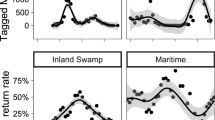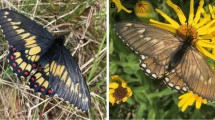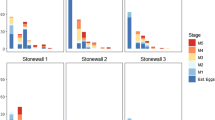Abstract
In Florida, the eastern North American population of the monarch butterfly exhibits geographic variability in population structure and dynamics. This includes the occurrence of migrants throughout the peninsula during the autumnal migration, occasional overwintering clusters that form along the Gulf Coast, remigrants from Mexico that breed in north-central Florida during the spring, and what have been assumed to be year-round, resident breeding populations in southern Florida. The work reported here focused on two monarch populations west of Miami and addressed four questions: Are there permanent resident populations of monarchs in southern Florida? Do these breed continuously throughout the year? Do they receive northern monarchs moving south during the autumn migration? Do they receive overwintered monarchs returning via Cuba or the Yucatan during the spring remigration from the Mexican overwintering area? Monthly collections and counts of spermatophores in the bursa copulatrices of females established that a resident population of continuously breeding monarchs exists year-round in southern Florida. It was determined through cardenolide fingerprinting that most of the butterflies had bred on the local southern Florida milkweed species, Asclepias curassavica. During the autumn migration period, however, some monarchs had fed on the northern milkweed, Asclepias syriaca. It appears that instead of migrating to Mexico, these individuals travel south through peninsular Florida, break diapause, mate with and become incorporated into the resident breeding populations. None of the monarchs captured in spring had the A. syriaca cardenolide fingerprint, which is evidence against the southern Florida populations receiving overwintered remigrants from Cuba, Central America or Mexico.

Similar content being viewed by others
References
Ackery, P. R. and Vane-wright, R. I. 1984. Milkweed Butterflies: Their Cladistics and Biology. Cornell University Press, Ithaca, New York.
Alonso-mejia, A., Rendon-salinas, E., Montesinos-patino, E., and BROWER, L. P. 1997. Use of lipid reserves by monarch butterflies overwintering in Mexico: implications for conservation. Ecol. Appl. 7:934–947.
Anderson, J. B. and Brower, L. P. 1996. Freeze-protection of overwintering monarch butterflies in Mexico: critical role of the forest as a blanket and an umbrella. Eco. Entomol. 21:107–116.
Anon. 1999. Southeastern Regional Climate Center. Climate data for the southeastern U.S. (Stations: Gainesville, FL and Miami, FL Airports, 1961–1990). //water.dnr.state.sc.us/climate/se/.cc
Barcant, M. 1970. Butterflies of Trinidad and Tobago. Collins, London.
Barker, J. F. and Herman, W. S. 1976. Effect of photoperiod and temperature on reproduction of the monarch butterfly, Danaus plexippus. J. Insect Physiol. 22:1565–1568.
Brower, L. P. 1962. Evidence for interspecific competition in natural populations of the monarch and queen butterflies, Danaus plexippus and D. gilippus berenice in south central Florida. Ecology, 43:549–552.
Brower, L. P. 1984. Chemical defence in butterflies, pp. 109–134, in R. I. Vane-Wright and P. R. Ackery (eds.). The Biology of Butterflies. Academic Press, London.
Brower, L. P. 1985. New perspectives on the migration biology of the monarch butterfly, pp. 748–785, in M. A. Rankin (ed.). Danaus plexippus L. Migration: Mechanisms and Adaptive Significance. University of Texas, Austin.
Brower, L. P. 1995. Understanding and misunderstanding the migration of the monarch butterfly (Nymphalidae) in North America: 1857–1995. J. Lep. Soc., 49:304–385.
Brower, L. P., Seiber, J. N., Nelson, C. J., Tuskes, P., and Lynch, S. P. 1982. Plant-determined variation in the cardenolide content, thin layer chromatography profiles, and emetic potency of monarch butterflies, Danaus plexippus reared on the milkweed, Asclepias eriocarpa in California. J. Chem. Ecol. 8:579–633.
Brower, L. P., Fink, L. S. and Walford, P. 2006. Fueling the fall migration of the monarch butterfly. Integr. Comp. Biol. 46: 1123–1142.
Cohen, J. A. 1983. Chemical interactions among milkweed plants (Asclepiadaceae) and lepidopteran herbivores. PhD dissertation, University of Florida, Gainesville.
Cohen, J. A. 1985. Differences and similarities in cardenolide contents of queen and monarch butterflies in Florida and their ecological and evolutionary implications. J. Chem. Ecol. 11:85–103.
Dockx, C., Brower, L. P., Wassenaar, L. I., and Hobson, K. A. 2004. Do North American monarch butterflies travel to Cuba? Stable isotope and chemical tracer techniques. Ecol. Appl. 14:1006–1114.
Farrey, B. and Davis, A. K. 2004. Monarch butterfly larvae (Lepidoptera: Nymphalidae) with 3 tubercle pairs in south Florida. Fl. Entomol. 87:408–411.
Frey, D. and Schaffner, A. 2004. Spatial and temporal pattern of monarch overwintering abundance in western North America, pp. 167–176, in K. Oberhauser and M. Solensky (eds.). The Monarch Butterfly: Biology and Conservation. Cornell University Press, Ithaca.
Funk, R. S. 1968. Overwintering of monarch butterflies as a breeding colony in southwestern Arizona. J. Lep. Soc. 22:63–64.
Haber, W. A. 1993. Seasonal migration of monarchs and other butterflies in Costa Rica, pp. 201–208, in S. B. Malcolm and M. P. Zalucki (eds.). Biology and Conservation of the Monarch Butterfly. Publications of the Los Angeles County Museum of Natural History, Los Angeles, California.
Herman, W. S., Brower, L. P., and Calvert, W. H. 1989. Reproductive tract development in monarch butterflies overwintering in California and Mexico. J. Lep. Soc. 43:50–58.
James, D. G. 1993. Migration biology of monarchs in Australia, pp. 189–200, in S. B. Malcolm and M. P. Zalucki (eds.). Biology and Conservation of the Monarch Butterfly. Publications of the Los Angeles County Museum of Natural History, Los Angeles, California.
Knight, A. L. 1998. A population study of monarch butterflies in north-central and south Florida. MS thesis, University of Florida, Gainesville.
Knight, A. L., Brower, L. P. and Williams, E. H. 1999. Spring remigration of the monarch butterfly, Danaus plexippus (Lepidoptera: Nymphalidae) in north central Florida: estimating population parameters using mark-recapture. Biol. J. Linnean Soc. 68:531–556.
Larsen, K. L., and Lee, R. E., Jr. 1994. Cold tolerance including rapid cold-hardening and inoculative freezing of fall migrant monarch butterflies in Ohio. J. Insect Physiol. 40:859–864.
Malcolm, S. B. 1991. Cardenolide-mediated interactions between plants and herbivores, pp. 251–296, in G. A. Rosenthal and M. R. Berenbaum (eds.). Herbivores: Their Interactions with Secondary Plant Metabolites, 2E Volume 1: The Chemical Participants. Academic Press, New York.
Malcolm, S. B. and Brower, L.P. 1986. Selective oviposition by monarch butterflies (Danaus plexippus L.) in a mixed stand of Asclepias curassavica L. and A. incarnata L. in south Florida. J. Lep. Soc., 40:255–263.
Malcolm, S. B., Cockrell, B. J., and Brower, L. P. 1987. Monarch butterfly voltinism: effects of temperature constraints at different latitudes. Oikos, 49:77–82.
Malcolm, S. B., Cockrell, B. J., and Brower, L. P. 1989. Cardenolide fingerprint of monarch butterflies reared on common milkweed, Asclepias syriaca L. J. Chem. Ecol. 15:819–853.
Malcolm, S. B., Cockrell, B. J., and Brower, L. P. 1993. Spring recolonization of eastern North America by the monarch butterfly: successive brood or single sweep migration?, pp. 253–267, in S. B. Malcolm and M. P. Zalucki (eds.). Biology and Conservation of the Monarch Butterfly. Publications of the Los Angeles County Museum of Natural History, Los Angeles, California.
Martin, R. A., Lynch, S. P., Brower, L. P., Malcolm, S. B. and Van hook, T. 1992. Cardenolide content, emetic potency, and thin-layer chromatography profiles of monarch butterflies, Danaus plexippus, and their larval host-plant milkweed, Asclepias humistrata Walt., in Florida. Chemoecology 2:1–13.
Moranz, R. and Brower, L. P. 1998. Geographic and temporal variation of cardenolide-based chemical defenses of Queen butterfly (Danaus gilippus) in Northern Florida. J. Chem. Ecol. 24: 905–932.
Pliske, T.E. 1973. Factors determining mating frequencies in some New World butterflies and skippers. Ann. Entomol. Soc. Am. 66:164–169.
Rawlins, J. E., and Lederhouse, R. C. 1981. Developmental influences of thermal behavior on monarch caterpillars (Danaus plexippus): an adaptation for migration (Lepidoptera: Nymphalidae: Danainae) J. Kansas Entomol. Soc., 54:387–408.
Seiber, J. N., Brower, L.P., Lee, S. M., Mcchesney, M. M., Cheung, H. T. A., Nelson, C. J., and Watson, T. R. 1986. Cardenolide connection between overwintering monarch butterflies from Mexico and their larval foodplant, Asclepias syriaca. J. Chem. Ecol. 12: 1157–1170.
Suzuki, Y. and Zalucki, M. P. 1986. The influence of sex ratio on female dispersal in Danaus plexippus (L.) (Lepidoptera: Danaidae). J. Austral. Entomol. Soc. 25:31–35
Urquhart, F. A. 1960. The Monarch Butterfly. University of Toronto Press, Toronto.
Urquhart, F. A. and Urquhart, N. R. 1976. A study of the peninsular Florida populations of the monarch butterfly (Danaus p. plexippus: Danaidae). J. Lep. Soc., 30:73–87.
Urquhart, F. A., Urquhart, N. R., and Munger, F. 1970. A study of a continuously breeding population of Danaus plexippus in southern California compared to a migratory population and its significance in the study of insect movement. J. Res. Lep., 7:169–181.
Van hook, T. 1999. The use of the bursa copulatrix dissection and abdominal palpation to assess female monarch butterfly mating status, pp. 101–111, in J. Hoth, L. Merino, K. Oberhauser , I. Pisanty, S. Price, and T. Wilkinson (eds.). 1997 North American Conference on the Monarch Butterfly. Commission for Environmental Cooperation, Morelia, Mexico.
Walker, T. J. 2001. Butterfly migrations in Florida: seasonal patterns and long-term changes. Ecol. Entomol. 30:1052–1060
Wassenaar, L. I. and Hobson, K. A. 1999. Natal origins of migratory monarch butterflies at wintering colonies in Mexico: new isotopic evidence. Proc. Natl. Acad. Sci. U S A 95:15436–15439.
Williams, C. B. (1958) Insect Migration. Collins, London.
Woodson, R. E., Jr. 1954. The North American species of Asclepias L. Ann. Miss. Bot. Gard., 41:1–211.
Wyatt, R. 1996. More on the southward spread of common milkweed, Asclepias syriaca L. Bull. Torrey Bot. Club 123:68–69.
Zalucki, M.P. 1982. Temperature and rate of development in Danaus plexippus L. and D. chrysippus L. (Lepidoptera: Nymphalidae). J. Austral. Entomol. Soc. 21:241–246.
Acknowledgement
We thank Cal Dodson for showing Brower the locations of various southern Florida monarch populations in 1968 and Reverend Jack Hill of Graham Baptist Church for allowing us to use his facilities. We also thank Dan Hipes, Cristina Dockx, Ray Moranz, and Natalia Arango-Velez for help with field work, and Carmen Lanciani, Thomas Walker, Dan Hipes, and Linda Fink for critiquing the manuscript. Shannon Gibbs and Ray Moranz helped develop the Adobe Photoshop-based sorting system used to distinguish the fingerprint patterns. The research was supported by U.S. NSF grant DEB 922091 to the University of Florida, with L. P. Brower as principal investigator, and by the Wildlife Conservation Society of New York.
Author information
Authors and Affiliations
Corresponding author
Rights and permissions
About this article
Cite this article
Knight, A., Brower, L.P. The Influence of Eastern North American Autumnal Migrant Monarch Butterflies (Danaus plexippus L.) on Continuously Breeding Resident Monarch Populations in Southern Florida. J Chem Ecol 35, 816–823 (2009). https://doi.org/10.1007/s10886-009-9655-z
Received:
Revised:
Accepted:
Published:
Issue Date:
DOI: https://doi.org/10.1007/s10886-009-9655-z




